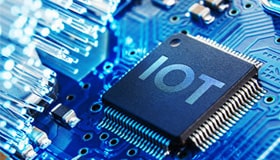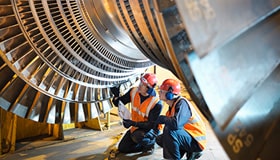Inductors demystified: exploring their function and applications
An inductor is a passive electronic component that stores energy in a magnetic field when an electrical current flows through it. It consists of a conductor, usually in the form of a wire, wound around a magnetic core, which can be made of various materials such as air, iron, or ferrite. The inductor opposes changes in current by creating a back electromotive force (EMF) that opposes the change in current flow. The unit of inductance is the Henry, and the symbol for inductance is "L."
Inductors are commonly used in electronic circuits to filter, store, and transfer energy. They are used in power supplies to smooth out fluctuations in the output voltage, and in signal processing circuits to filter out unwanted frequencies. They are also used in radio frequency (RF) circuits, where they can be used as antennas or in tuning circuits. Additionally, inductors can be used in transformers to transfer electrical power from one circuit to another at different voltage levels.
This guide covers topics as below:
- Basic operation principles of inductor
- Types of inductors
- Air-core inductors
- Iron-core inductors
- Ferrite-core inductors
- Toroidal inductors
- SMD inductors
- Inductor Parameters
- Applications of inductors
Basic operation principles of inductor
Inductors operate based on the relationship between current and magnetic fields. When an electric current flows through a wire, a magnetic field is created around the wire, and the strength of the magnetic field increases with the current. When the wire is coiled, the magnetic field is concentrated in the center of the coil and its strength is proportional to the number of turns and the current flowing through it.
When the current flowing through the coil changes, the magnetic field changes as well. This change in the magnetic field generates a voltage that opposes the change in current flow, which is called the back electromotive force (EMF). The strength of the back EMF is proportional to the rate of change of the current in the coil. Therefore, when the current is increasing, the back EMF opposes the increase, and when the current is decreasing, the back EMF opposes the decrease.
Types of inductors:
There are several types of inductors used in electronic circuits, including:
Air-core inductors
Air-core inductors are a specific type of inductor that use a non-magnetic core, such as air or plastic, with a coil of wire wound around it. They find application in various electronic circuits, including high-speed digital circuits, power electronics, and radio frequency (RF) circuits.
One of the significant advantages of using air-core inductors is their low magnetic interference. They do not use a magnetic core that can cause magnetic fields to leak out and interfere with nearby circuits. Consequently, air-core inductors are ideal for circuits that require a high level of signal purity, such as radio transmitters and receivers.
Another important advantage of air-core inductors is their high Q factor, which determines the quality of an inductor's performance. A high Q factor signifies that the inductor can store energy for a longer duration, making it useful in RF circuits that require the transmission of signals over long distances with minimal signal loss.

Figure 1: Air core inductor
Iron-core inductors
Iron-core inductors are a type of inductor that uses a magnetic core, typically made of iron or ferrite, with a coil of wire wound around it. They are widely used in various electronic circuits, including power electronics, transformers, and inductors used for energy storage and filtering.
One of the significant advantages of iron-core inductors is their high inductance value. They are suitable for use in applications that require a large amount of inductance, such as power electronics. The magnetic core material provides a high permeability, which increases the magnetic field strength and allows for a higher level of energy storage.
Iron-core inductors also have a high level of magnetic coupling between the windings. This means that energy can be transferred more efficiently from the input to the output of the inductor, making them ideal for use in transformers where energy is transferred between two coils of wire through a magnetic field.

Figure 2: Iron core inductor
Ferrite-core inductors
Ferrite-core inductors use a magnetic core made of ferrite, a ceramic material composed of iron oxide and other metal oxides. They offer several advantages over other inductor types, including high inductance, low magnetic losses, and high frequency capabilities.
Their high inductance makes them ideal for use in applications that require a large amount of inductance, such as power electronics and RF circuits. The ferrite material has a high magnetic permeability, which enables it to store a large amount of magnetic energy. Additionally, they have low magnetic losses due to the material's low hysteresis loss, which allows for efficient energy storage and minimal energy loss.
Ferrite-core inductors also have high frequency capabilities, enabling them to operate at high frequencies without significant energy losses or distortions. They are commonly used in power supplies, amplifiers, and RF circuits.
However, ferrite-core inductors can be more expensive and difficult to manufacture than other types of inductors, which can make them less suitable for cost-sensitive applications.

Figure 3: Ferrite core inductors
Toroidal inductors
Toroidal inductors are a type of inductor with a donut-shaped core made of a ferrite or powdered iron material, and wire windings wrapped around the core. The circular shape of the core provides several advantages, such as a high level of inductance for their size and low electromagnetic interference (EMI) emissions. The magnetic flux is contained within the core, which leads to more efficient use of space and better performance. The low EMI emissions make them ideal for use in applications where minimizing EMI is critical.
Toroidal inductors also have a lower resistance than other types of inductors, making them more efficient at storing and releasing energy, which makes them suitable for use in power supply and audio amplifier applications. They have a uniform magnetic field and a low level of magnetic hysteresis, providing consistent performance over a wide range of frequencies and temperatures.
However, toroidal inductors have some disadvantages, including higher cost due to manufacturing processes and materials used, and more difficult winding and soldering due to their shape. Despite these limitations, toroidal inductors are widely used in various electronic devices and equipment, such as audio amplifiers, power supplies, and RF circuits.

Figure 4: Toroidal inductor
SMD inductors
SMD (Surface Mount Device) inductors are specifically designed for surface-mount applications in electronics. These inductors are constructed using thin, flat wire that is wound around a core made of magnetic material, such as ferrite or powdered iron. To ensure longevity and durability, the winding is then coated with a protective layer of epoxy or other materials.
The compact size of SMD inductors makes them ideal for use in electronic devices where space is limited. They are easy to mount onto a printed circuit board (PCB) using automated assembly techniques like pick-and-place machines, which greatly speeds up the manufacturing process.
SMD inductors are available in a range of sizes, values, and different shapes and types of cores, which makes them versatile and suitable for a variety of applications, such as filtering, signal conditioning, and power supply regulation.
One of the key advantages of SMD inductors is their high level of reliability and durability. They are designed to withstand the harsh conditions of use in electronic devices, including high temperatures, vibration, and shock.
Another benefit of SMD inductors is their low profile, which takes up less space on the PCB than traditional through-hole inductors. This allows for greater PCB density and more compact designs, making them an excellent choice for miniaturized electronic devices.

Figure 5: SMD inductor
Inductor Parameters
The parameters of an inductor include the following:
Inductance
Inductance is an important concept in electrical circuits that describes how a circuit element can store energy in a magnetic field. The unit of measurement for inductance is the henry (H), named after the physicist Joseph Henry, who discovered electromagnetic induction independently of Michael Faraday. Inductance is commonly represented by the symbol "L" and is defined as the ratio of the voltage across a circuit element to the rate of change of current through it. Mathematically, this can be expressed as L = V / (dI/dt), where L is inductance, V is voltage, and dI/dt is the rate of change of current over time. Inductance is produced by the interaction between an electric current and a magnetic field. As a current flows through a wire or coil, it generates a magnetic field around it. This magnetic field then induces a voltage in any nearby conductive material, such as another wire or coil.
DC resistance
The DC resistance of an inductor measures how much it opposes the flow of direct current through it. It is measured in ohms and is affected by the wire's length and cross-sectional area. When direct current flows through an inductor, it creates a magnetic field that stores energy. This energy is released when the current is turned off, creating inductance, which filters and stores energy. minimizing the DC resistance is important because it impacts the efficiency and performance of inductors in DC circuits. Ohm's law is used to calculate the DC resistance, and it can be affected by temperature, wire material, and coating. When selecting inductors, lower DC resistance is preferred for high-performance applications that require higher efficiency.
Q factor
The Q factor, or quality factor, is a measure of how efficiently an inductor can store and release energy. It is calculated as the ratio of energy stored in the inductor to energy lost as heat during each cycle of oscillation. Mathematically, the Q factor is expressed as Q = 2πfL / R, where f is the resonant frequency of the inductor, L is the inductance, and R is the resistance of the inductor.
A higher Q factor means that the inductor is more efficient in storing energy, whilst a lower Q factor means that the inductor loses energy more readily. In the design and selection of inductors, the Q factor is an important parameter, especially for applications that require high efficiency and low power loss. For instance, high-Q inductors are used in RF circuits to tune circuits to specific frequencies with minimal power loss.
The Q factor of an inductor is influenced by various factors such as wire material, wire diameter, core material, and core shape. Using high-conductivity wire, minimizing wire diameter, and selecting high-quality core materials can improve the Q factor of an inductor. Additionally, the resonant frequency of the inductor affects its Q factor, which is highest at the resonant frequency. Therefore, selecting the appropriate resonant frequency is crucial in achieving the desired level of efficiency for a particular application.
Self-resonant frequency
The self-resonant frequency is the frequency at which an inductor exhibits maximum reactance and minimum impedance, behaving like a resonant circuit. At this frequency, the inductor's reactance nullifies its resistance, resulting in a purely resistive impedance. The self-resonant frequency is determined by the inductance of the coil, the capacitance between the coil's turns, and the distributed capacitance between the coil and other conductive elements in the circuit. It can be calculated using the formula f = 1 / (2π √LC), where L is the inductance of the coil, C is the total capacitance, and f is the self-resonant frequency.
Inductors exhibit increasing reactance at frequencies above the self-resonant frequency and decreasing reactance at frequencies below it. The self-resonant frequency is a critical parameter when selecting and designing inductors for high-frequency applications, as operating an inductor above its self-resonant frequency can result in decreased efficiency, excessive heat dissipation, and even damage to the inductor.
The self-resonant frequency can be shifted by changing the physical properties of the coil or the circuit it is connected to. This can be accomplished by adjusting the number of turns in the coil, changing its physical size or shape, or altering the capacitance in the circuit. Understanding the self-resonant frequency and how to adjust it is crucial for designing and selecting inductors for high-frequency circuits.
Saturation current
The saturation current of an inductor is a critical factor in determining the maximum current that an inductor can handle before its inductance starts to decrease due to magnetic saturation of the core material. When the core material becomes saturated, the magnetic field strength in the core reaches a maximum level, causing the inductance of the coil to decrease. Several factors, such as the core material, core geometry, wire size, and number of turns in the coil, determine the saturation current of an inductor.
Typically, inductors with larger cores and more wire turns can handle higher currents before reaching magnetic saturation. Selecting an inductor with an appropriate saturation current is crucial when designing a circuit that requires high currents. Inductor manufacturers provide a datasheet that includes the inductor's saturation current, which can be calculated or estimated based on the core material and geometry. It is important to select an inductor with a saturation current higher than the maximum current expected in the application to prevent saturation-induced performance degradation.
Temperature coefficient
The temperature coefficient of an inductor is a percentage measurement of how the inductance of the coil changes in relation to temperature. It is typically expressed in parts per million per degree Celsius (ppm/°C) and can be found in the inductor's datasheet. The temperature coefficient is a crucial factor to consider when selecting an inductor for applications where temperature variations are significant. The temperature coefficient is influenced by the material properties of the coil and core material. As the temperature increases, the resistance of the coil and core material also increases, resulting in a reduction in inductance. The temperature coefficient can be either positive or negative, depending on the specific design of the inductor and the materials used.
The temperature coefficient is particularly important in applications that require high-precision measurement or regulation, such as inductor-based filters used in high-frequency applications such as radio and telecommunications. A stable inductance over a wide temperature range is essential to avoid distortion and other issues.
Applications of inductors
Inductors have a wide range of applications in various fields such as electronics, power generation and distribution, telecommunications, and more. Here are some common applications of inductors:
- Filtering: Inductors are often used in conjunction with capacitors to create filters that can remove unwanted frequencies from signals. This is commonly used in audio equipment, power supplies, and communication systems.
- Power supply and DC-DC conversion: Inductors are used in power supplies and DC-DC converters to store energy and regulate current flow. They can help reduce noise, improve efficiency, and provide a stable output voltage.
- Energy storage: Inductors can store energy in magnetic fields, which can be released when the current flow is interrupted. This is used in a variety of applications such as pulse generators, high-voltage power supplies, and electric motors.
- Tuning circuits: Inductors can be used in tuning circuits to adjust the frequency response of filters or resonant circuits.
- Transformers: Inductors can be used as the primary or secondary coils in transformers to transfer energy from one circuit to another. Transformers are used in power distribution systems, electronic devices, and more.
- Sensors: Inductors can be used as sensors in various applications such as proximity sensing, metal detection, and magnetic field measurement.
- Lighting: Inductors are used in fluorescent and high-intensity discharge (HID) lighting to control the flow of current and provide a stable output.
- Medical equipment: Inductors are used in medical equipment such as MRI machines and pacemakers.
Newark has partnered with many different suppliers with fixed resistors portfolio includes inductors, charging coil arrays, charging coils, coupled inductors, fixed value inductors, high frequency inductors, inductor kits & assortments, inductors, power factor correction chokes, power inductors, RF inductors, toroidal inductors that can be used for different kind of applications in the industrial environment.







